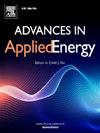Spatio-temporal load shifting for truly clean computing
IF 13.8
Q1 ENERGY & FUELS
引用次数: 0
Abstract
Companies operating datacenters are increasingly committed to procuring renewable energy to reduce their carbon footprint, with a growing emphasis on achieving 24/7 Carbon-Free Energy (CFE) matching—eliminating carbon emissions from electricity use on an hourly basis. However, variability in renewable energy resources poses significant challenges to achieving this goal. This study investigates how shifting computing workloads and associated power loads across time and location supports 24/7 CFE matching. We develop an optimization model to simulate a network of geographically distributed datacenters managed by a company leveraging spatio-temporal load flexibility to achieve 24/7 CFE matching. We isolate three signals relevant for informed use of load flexibility: (1) varying average quality of renewable energy resources, (2) low correlation between wind power generation over long distances due to different weather conditions, and (3) lags in solar radiation peak due to Earth’s rotation. Our analysis reveals that datacenter location and time of year influence which signal drives an effective load-shaping strategy. By leveraging these signals for coordinated energy procurement and load-shifting decisions, clean computing becomes both more resource-efficient and cost-effective—the costs of 24/7 CFE are reduced by 1.29 ± 0.07 €/MWh for every additional percentage of flexible load. This study provides practical guidelines for datacenter companies to harness spatio-temporal load flexibility for clean computing. Our results and the open-source optimization model offer insights applicable to a broader range of industries aiming to eliminate their carbon footprints.
时空负载转移,实现真正的干净计算
运营数据中心的公司越来越多地致力于采购可再生能源以减少碳足迹,越来越重视实现24/7无碳能源(CFE)匹配,即以小时为基础消除电力使用中的碳排放。然而,可再生能源的可变性对实现这一目标构成了重大挑战。本研究探讨了计算工作负载和相关的电力负载如何跨时间和地点转移以支持24/7 CFE匹配。我们开发了一个优化模型来模拟由一家公司管理的地理分布数据中心网络,利用时空负载灵活性来实现24/7 CFE匹配。我们分离出与负荷灵活性的明智使用相关的三个信号:(1)可再生能源的平均质量变化,(2)由于不同天气条件导致的长距离风力发电之间的低相关性,以及(3)由于地球自转导致的太阳辐射峰值滞后。我们的分析表明,数据中心的位置和一年中的时间会影响信号驱动有效的负载塑造策略。通过利用这些信号来协调能源采购和负载转移决策,清洁计算变得更加节约资源和成本效益-每增加一个百分比的灵活负载,24/7 CFE的成本就会降低1.29±0.07欧元/兆瓦时。本研究为数据中心公司利用时空负载灵活性进行清洁计算提供了实用指南。我们的研究结果和开源优化模型提供了适用于旨在消除碳足迹的更广泛行业的见解。
本文章由计算机程序翻译,如有差异,请以英文原文为准。
求助全文
约1分钟内获得全文
求助全文

 求助内容:
求助内容: 应助结果提醒方式:
应助结果提醒方式:


